It seems simple, right? Pressure, steam, plus short-time equals excellent results. It is almost that easy.
The instant pot works on a pressure basis. It can create significant pressure and temperature above 212°F (100°C) and force the heat into the food via the mentioned pressure to fast forward the cooking process.
That’s the basic idea behind it.
Even though this information is sufficient for most people, I started to ask my favorite question how.
How is it possible to create heat above the 212°F (100°C)? How does instant pot really work? How does pressure work? How is it possible that food is cooked so quickly?
And this led me to the trip of discovery and wonder.
If you would like to join me on this trip, please read on.
Instant pot or pressure cooker?
Before we dive right into the instant pot, let me clarify the difference between it and the pressure cooker.
By definition, they are the same and yet different.
The instant pot (also known as 3rd generation or electric pressure cooker) is an evolutionary step in the pressure cooker line. As the nickname suggests, the main difference is in control and handling, as the 2nd generation of pressure cookers is almost exclusively manual.
The electric generation introduced features as automatic heat control, pre-defined cooking times, and settings based on heating intensity, temperature, pressure, and duration.
It seems almost natural, right? Well, in the past, it was not the case. The pressure cooker (or manual pressure cooker) had to be controlled by a person. You had to make sure that the temperature is constant. Too low and it would take a long time to cook anything, too high, and you might end up either burning the food or creating too much pressure.
These days most of the electric pressure cookers or instant pots do this for you.
Instant pot parts
To understand and explain everything better, let’s first take a look at the essential parts of the instant pot.
Note: The whole article talks about the instant pot ie.: the 3rd generation of pressure cookers. You may find that some parts are slightly different on older types of them, but it doesn’t change the general function in any way.
I will be mentioning these as reference points in the sections below, so it is good to know them beforehand.
- Cooker base – Also called a body of the instant pot. It is an outer casing for the container itself. It provides a heat source via the heating part located at the bottom. It often includes a control panel that allows you to change your cooking settings.
- Two additional pieces of cookers base placed right below heating are bendable board and pressure sensor. When the pressure reaches the desired amount, it bends the board. It forces a pressure sensor to activate, signaling that the pressure level is reached and heating is stopped. And if the bendable board is not bent, it releases its push from the pressure sensor, and the heating is resumed. This system prevents pressure from building up to dangerous levels and keeps it at the perfect cooking level.
- The inner pot – Well, you always have to have one of those. Where else would you put your ingredients? Cooking pot of an instant pot is a significant part as it houses food and keeps the pressure inside itself. These days they tend to be made out of stainless steel, as it is the best material in terms of heating and health safety. Another common feature of the pot is a line marking the maximum capacity and maximum allowed volume of ingredients and liquids if you are pressure cooking. Also, it is worth mentioning and look for if you are planning to buy an instant pot is cooking handles. You should find them on the side of an inner container. They will allow you to work with pot quickly and safely.
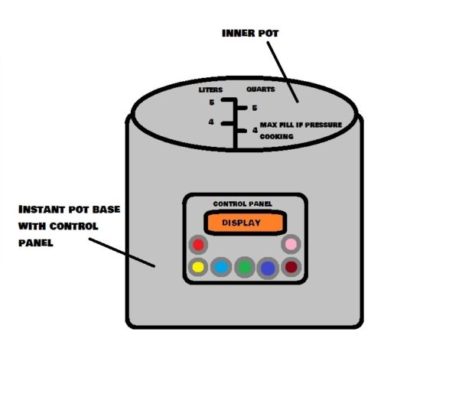
Note: If you own an older model of an instant pot (a pressure cooker), it might be made out of aluminum. These types were much cheaper, but also less safe as ones made out of stainless steel. The major downside with these is the problematic cleaning (you cannot use a dishwasher) and the inability to cook specific meals. The pressure cookers, the ones out of aluminum, tend to react to acidic food that can wear them down pretty fast.
- Cover or lid – its primary function is to cover, close the instant pot, and allow pressure to stay in the pot. This part is a bit more complicated, as it has a lot of features:
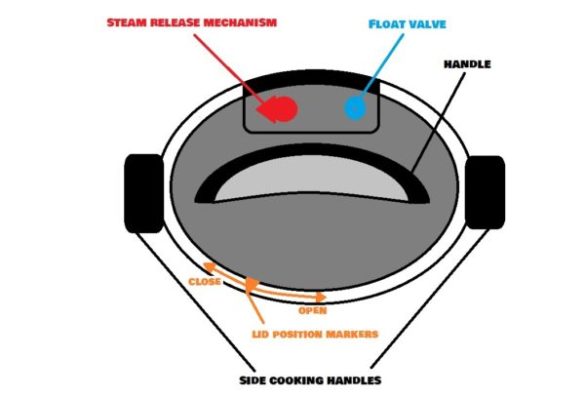
- Steam release mechanism (valve) – These may wildly differ model by model. In general, their purpose is to either keep (seal) the cover in place to allow pressure build-up or release (vent) the steam from the inner pot. Usually, when the internal pressure reaches a point beyond a safe operating level, the steam release activates and vents out the excess strain. This is a part of a sophisticated system of safety features about which you can find more here.
- Shield – Mesh-like thing placed at the bottom of the steam release to prevent bits of food from escaping from the pot. Imagine little food-bit riders on the back of steam horses. Without the shield, they would be able to get stuck in the steam release mechanism and prevent proper functioning.
- Sealing ring – Ring mostly made out of durable silicone. It is positioned on the bottom side of the lid. Its primary purpose is to create an airtight environment between the cover and inner pot when you set the steam release mechanism to keep. The ring is one of the critical parts. Without it, it is impossible to create pressure, as it would leave the inner pot when the boiling point is reached in the form of hot steam.
- Float valve – Created as one of the last lines of protection. This small valve with a silicone cap is pushed up when enough pressure builds up the instant pot. In a case of extreme stress created either by heat or pressure, it flys out of the lid and allows internal pressure to release.
These and other parts also serve as protection for you and your loved ones. If you are interested in the potential dangers of instant pots and how to avoid them, check out my article that’s answering the question: Are instant pot dangerous?
Instant pot’s cooking pressure
Do you remember the Queen? Under pressure song? This one:
The basic principle of pressure is in the lyrics.
Pushing down on me,
Pressing down on you,
No man ask for.
Under pressure.
Pressure is a constant thing that is happening all around us every second of every day.
But what is happening inside the instant pot? The principle is still the same, but the pressure is much higher.
The pressure is created by the inability of steam to release itself from the pot.
Pot is a sealed container in which you have ingredients and some form of liquid. Usually, when temperatures reach the boiling point of 212°F (100°C), the fluids on the surface turn from liquid state to steam and are released. You can observe this by looking for light grey hot vapor coming out of the pot when you are cooking.
Food is cooking in a pot, hot steam is being released, and you cover it with the lid. What will start happening? The steam is water turned to air and will be stopped by the cover and begin to turn back into the water.
This can be easily checked by lifting the lid from the pot. You will notice quite a significant amount of sizeable water drops on the bottom of the cover. The reason for the creation of these is the temperature difference between steam and the lid.
Please be careful if you are doing it for the first time.
If we could have to take a look inside the covered pot, we would see boiling liquid being turned to vapor on its surface. Steam being released and stopped by the lid on which it starts to change its form back to the water forming waterdrops. When waterdrops reach critical mass, they are released back to the pot, and the process can repeat itself.
This circle is continuously happening, but it cannot repeat itself indefinitely. There is a finite amount of PRESSURE which can build inside of the pot. Yes, apart from the steam and water being build and recreated inside a container, there is also pressure.
As the exchange between water and steam goes, there is a pressure building inside. Partially is the steam turned into waterdrops and partly is forced back into the pot and creates a sort of circulation inside it. More and more hot steam is added to the distribution as the boiling continues up until the critical mass is reached.
At this point, you most likely experience the 1st warning sign of water overboiling. The cover of your pot is jumping up and down. At this moment, the pressure inside the container is powerful enough to lift the lid by itself and release its parts in the form of steam to relieve the stress building up.
You lift the lid, release excess steam, mix the contents inside and cover it up again. And the cycle repeats.
Now, these are the basics of how pressure works in cooking. Knowing this, understanding how does this fit in the instant pot will be a breeze.
How does instant pot work
Heat, steam, boiling, condensation, circulation, the cycle, and much more. We now understand all the parts that we need.
The main difference between your ordinary pot and an instant pot is that the instant pot is locked by force and prevents steam from releasing itself out.
Let’s take a look inside the instant pot while it is working. In this case, we have quite a different environment than within a standard pot. Yes, the parts are the same but upgraded a bit.
You still have a container and ingredients. You still have boiling water, but this time the water is superheated (this is a unique state for water in which its temperature is above boiling point). The instant pot limits this point to 248°F (120°C), but it can go up to whooping 705°F (374°C).
This is possible due to the nature of instant pot, which is forcibly keeping everything sealed inside it. If you continuously add heat to anything, its temperature will rise. That’s why the liquid inside the pot can get over the 212°F (100°C) and create the superheated steam.
Do you remember the lid, steam release mechanism, and sealing ring that I have mentioned at the beginning? You need all those to keep the pressure inside the pot. See how good it was to describe them first?
Now we have an airtight container that quickly builds up heat, the steam is created, and the water is superheated — an excellent combination for some pressure to be made.
And there is a tremendous amount of pressure building up.
Now you might be asking, why is that happening.
All pressure cookers need at least a small amount of water or liquid of any type to work. Otherwise, the ingredients would burn almost immediately. Which is something you are not most likely looking for, right?
As heat builds up, the steam is created, and as it cannot escape the pot, it is forced back inside the food. Over time more steam is created and is pushed back into the ingredients at a faster pace. This is called building up the pressure, hence the pressure cooker.
At this point, the meal is being prepared by super hot steam that is being created, circulates, and partially condensates back into the food.
The pressure cooking can shorten the time needed for a recipe to be done to 1/4 or 1/3 of the original time required.
But the pressure cannot build up indefinitely if that were the case the pressure cooker would explode in the end. The rule is not more pressure = quicker cooking.
As we are talking about 3rd generation pressure cookers, we have to consider the fact that they have a small computer inside them. This baby takes care of moderating heat and pressure levels to keep the process as you defined it in the beginning.
So in the background, the instant pot changes the heating to regulate pressure build-up. This is controlled by a simple yet effective way, which I will explain in the pictures below.
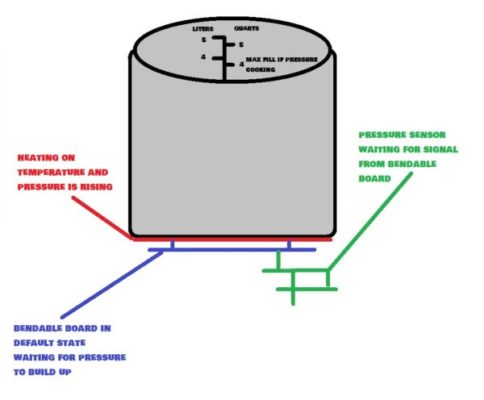
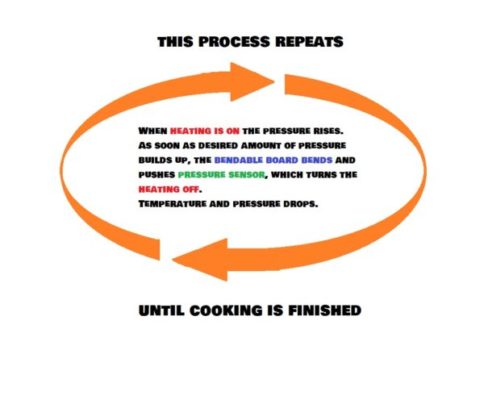
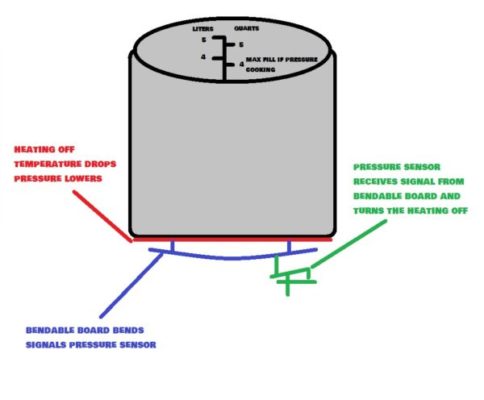
If this is still a bit unclear, let me help you with a beautiful explanation video:
Even though it is for kids, it is still one of the most accessible explanations that you can find.
After the pressure cooking is done, it will either self-release the pressure inside in a few minutes or fast forward this process by opening a release valve on the lid.
If you go with manual release, please be EXTRA CAREFUL. The steam inside is superheated from liquid, and if you stand above it, it might hurt you quite badly.
Keep your distance when turning the pressure valve and have some sort of hand protection, like mittens on your hands.
Final words
So to sum up how does instant pot work:
| You have your ingredients inside the airtight pot with a bit of water. |
| The container is heated up, and super hot steam is created out of water. |
| It cannot escape the pot and is forced back to food. |
| The moist circulating heat is fast-forwarding the cooking by a significant amount. |
And that is it. I hope I have been able to explain to you how does instant pot works. I am looking to meet you in my other articles.
Until next time I wish you a happy and pressurized cooking.

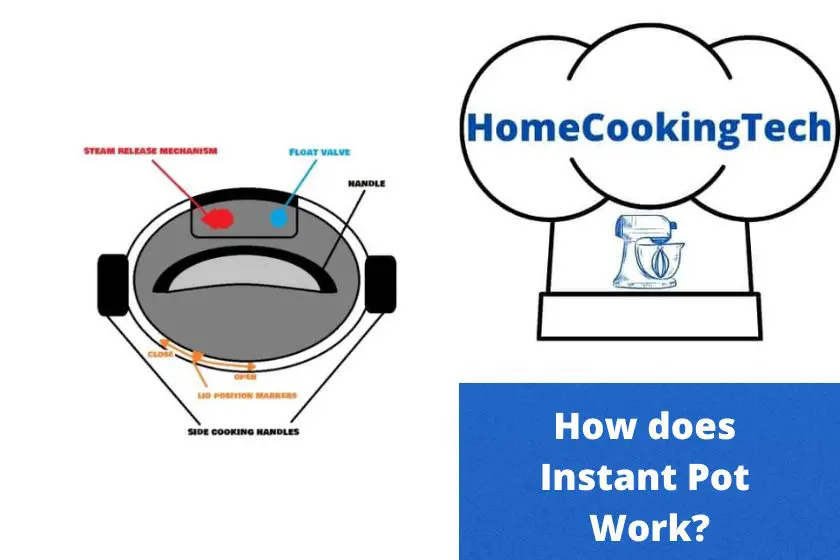



















5 responses to “How Does Instant Pot Work?”
[…] cooking, slow cooking, and other functions, rather than deep frying or pan frying. Understanding how instant pot functions helps in making the best use of its features and exploring its vast cooking […]
[…] cooking with an Instant Pot, the lid traps steam and moisture inside the pot. As the pressure builds up, excess moisture is […]
[…] pressure cooker, the Instant Pot Duo Mini 7-in-1 Electric Pressure Cooker is a great option. With 11 built-in programs, you can easily cook your favorite dishes with the touch of a button. Plus, it comes with a […]
[…] this article, I’ll cover everything you need to know to get started with your Instant Pot, from cooking techniques to simple recipes and even meal prepping. Whether you’re looking to eat healthier or just want to […]
[…] and easy way to prepare a healthy side dish that is packed with nutrients. With the Instant Pot’s pressure cooking capabilities, you can cook broccoli to perfection in just a few minutes. In this article, I will guide you […]